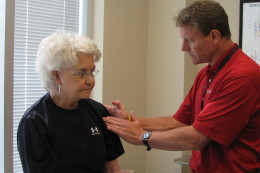If you need a shoulder replacement, rotator cuff repair or cartilage repair, it’s important to find a surgeon with specific experience in the most recent treatment advancements that achieve improved outcomes.
 At Janssen Orthopedics in Huntsville, we’re performing state-of-the-art procedures that effectively repair the most serious shoulder injuries. When appropriate, we use a minimally invasive technique to give you long-lasting results with a faster recovery than you could expect with older surgical methods.
At Janssen Orthopedics in Huntsville, we’re performing state-of-the-art procedures that effectively repair the most serious shoulder injuries. When appropriate, we use a minimally invasive technique to give you long-lasting results with a faster recovery than you could expect with older surgical methods.
We offer these and other shoulder procedures:
- Rotator cuff repair
- GRAFTJACKET® procedure for large rotator cuff tears
- Cartilage repair for labral tears or shoulder instability
- Total shoulder replacement
- Reverse total shoulder replacement, the latest option for people with severe rotator cuff or other shoulder problems
- Minimally invasive arthroscopic shoulder surgery
Janssen Orthopedics treats sports injuries to the shoulder as well as other injuries and painful conditions, including:
Rotator cuff tears
Your rotator cuff is a group of muscles that come together as tendons and attach your upper arm bone (humerus) to the shoulder blade.
One or more of these tendons can be injured, usually with wear and tear over time, or because of an injury, such as falling on an outstretched arm or lifting a heavy object. Rotator cuff tears are also common sports injuries, especially for baseball pitchers and tennis players.
Damage to the rotator cuff can be either a partial tear, or a complete, full-thickness tear. The most common symptoms include pain at rest, pain with specific movements and weakness when rotating the arm.
Conservative management of rotator cuff tears includes rest, medication, physical therapy and possibly steroid injections. For injuries that don’t respond to these approaches, or for large rotator cuff tears, Dr. Janssen offers are a number of surgical options for repair and reconstruction, including less invasive and completely arthroscopic, minimally invasive procedures. Click here to watch Dr. Janssen perform an Arthroscopic Rotator Cuff Repair.
Tendonitis & bursitis of the shoulder
Tendonitis and bursitis are two related types of inflammation in the shoulder. The tendons of the rotator cuff, which attach your upper arm bone to your shoulder, can become irritated and inflamed from overuse in sports or at work, or from holding the arm in one position for long periods of time. These tendons pass over a protective, fluid-filled sac called the bursa, which can also become swollen and inflamed.
Together, these conditions can cause so much swelling that the soft tissues become squeezed, or impinged, between the bones that make up the shoulder. Early symptoms of rotator cuff tendonitis, bursitis and shoulder impingement include minor pain and sudden pain with certain movements (reaching, or for athletes, throwing a ball or serving in tennis). Without treatment, you may experience a loss of strength or range of motion and have trouble performing some everyday activities.
Most people with shoulder tendonitis, bursitis or shoulder impingement get significant relief with rest and prescribed nonsurgical treatments.
Shoulder instability
If you’ve ever had a partial or complete shoulder dislocation, from an injury or because of repetitive motions in sports or work, you’re at risk for shoulder instability. This means your shoulder has become loose in its socket and may slip out of place repeatedly.
Activity modification, physical therapy and medications may help make your shoulder more stable. If you have stretched or damaged ligaments in the shoulder, surgical repair may fix your problem. Depending on the cause and severity of your shoulder instability, you may be a good candidate for a minimally invasive arthroscopic procedure, which is performed through a small incision using tiny instruments.
You don’t have to live with the pain of shoulder instability or the way it limits your activities. Dr. Janssen can evaluate your shoulder and recommend a personalized treatment plan to manage or completely resolve your problem.
Osteoarthritis
 Osteoarthritis of the shoulder comes with age and wear-and-tear. It can develop in younger people, but usually affects people age 50 or older. With osteoarthritis, the articular cartilage that covers the tops of bones is worn down, causing pain, swelling and immobility.
Osteoarthritis of the shoulder comes with age and wear-and-tear. It can develop in younger people, but usually affects people age 50 or older. With osteoarthritis, the articular cartilage that covers the tops of bones is worn down, causing pain, swelling and immobility.
Conservative management of shoulder osteoarthritis can involve rest, proper self-care, medication, physical therapy, at-home exercises and even nutritional supplements. For people who continue to have severe pain, surgery, particularly shoulder joint replacement, may be the best option.

